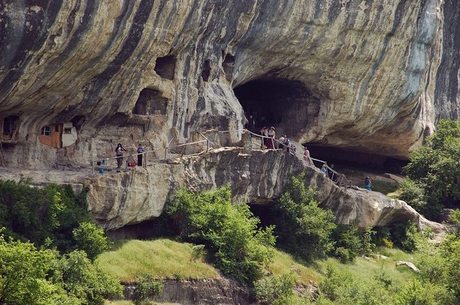Cave Monastery Chelter-Koba
In the valley of the river above the village Belbek Small Garden tower three rocky promontory. On the eastern cape Kul-Burun (Tower cape) is Syuyrenskaya fortress.
From there remained part of the defensive wall and tower, built around VIII century. It is believed that the second floor of the tower later staged a church. It was painted with frescoes of which only fragments remain.
the right of the building, a cliff of Cape Ai-Todor in the Middle Ages arose a small monastery. The vicinity of the fortress is not accidental, took place near the northern border of the Principality of Theodoro, which Syuyrenskaya and defended fortress. For its thick walls in case of danger could hide villagers and monks.
To examine the monastic caves, it is necessary, passing small village of Garden, walk along a dirt road up the gorge. This valley, which divided the tower cape and cape Ai-Todor, overgrown bushes, dogwood, juniper, blackthorn, trees. Then you turn off the main road to the right and climb to the foot of cliffs in the steep sides of which are seen the cave.
The monastery was founded in VIII-IX century and existed until 1475, while the Turkish army invaded the Crimea and captured the principality of Theodoro. The monastery was named St. Theodore, it is preserved in the name of the rock. Here there are 22 caves of different sizes and purposes. This cell of monks, some of them quite small with low ceilings, storage caves, chambers of economy, large refectory hall and, most importantly, the cave temple. It is located in a large natural grotto area of over 150 sq. km. meters. The grotto has a rounded shape, tapering to the east and west. To cut down the altar is a special rectangular hollow in the walls of which placed the niche. Low altar barrier separated the apse from the rest of the church. In the north-eastern part of the church was located font. Along the northern and southern walls stretch the bench in the walls of tombs cut in the floor - four graves, one of them a little, perhaps, children, five more graves are located in the western part of the temple. Such a number of graves gives reason to believe that buried in the monastery, not only monks, but also the defenders. The number of monks living in a monastery, was small, only 14-16 people. Therefore, in the great temple Chelter-Koba prayed and monks, and warriors Syuyrenskoy fortresses, and residents of surrounding villages.
Usually monasteries with the refectory, which include Chelter-Koba, were particularly esteemed, in their temples were relics of the saints and other relics. These monasteries were visited by a large number of pilgrims. Just do not know, in honor of the three saints Theodoro - Stratilata, Tyrone or Studite - called a monastery. It is believed that it was Theodore.
Saint Theodore was born in Constantinople in 758 year. It is known that the restored and furnished Studion monastery, it increased the number of monks to 1000 people. Rev. Theodore was a strict monastic charter, which was adopted in Kiev-Pechersk Lavra. This charter and called Studion. During the reign of Emperor Leo V the Armenian fans began a new persecution of the icons. St Theodore and his brethren made a procession with the icons around the monastery, displaying courage in defending the faith. For this the Emperor sent him into exile, where the holy subjected torture, were not given food and water, but the Reverend Theodore bore all with meekness and prayer. After some time the Emperor Leo V the Armenian was killed by insurgent soldiers. The new emperor Michael II, although it was not a fan of the veneration of icons, freed from captivity of all Christians. St. Theodore wrote many instructive books and church hymns. He died in the year 826, the church honors the memory of his November 24.
In ancient times all the caves of the monastery were joined with wooden staircases and passages, so the Tatars and gave him the name Chelter-Koba ( "Chelter" means "grill", "Coba" - "Cave »).
If the temple to pass on the edge of the cliff, you can see a long cave that leads to the source. In January 2001, visited the ancient monastery Metropolitan of Simferopol and Crimea Lazar. After examining the cave temples and the source, he said: "The place is set up for prayer, and to breathe life again into the monastery walls. Perhaps another abode will soon be reborn in the Crimean land.
You can get there by direct flight to Simferopol or through Kiev or Odessa.




